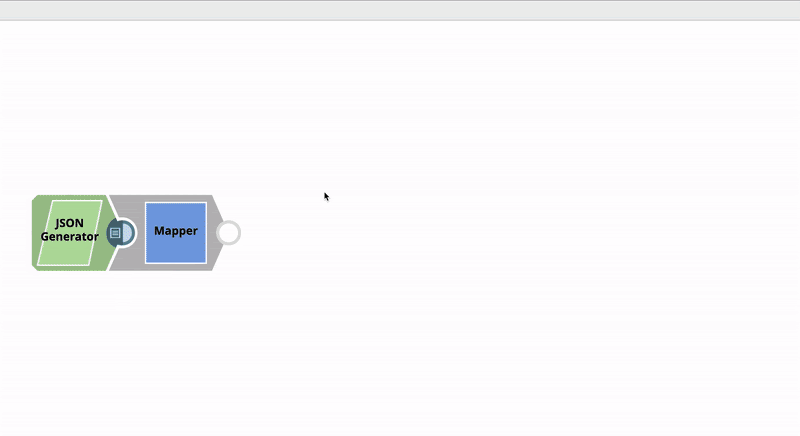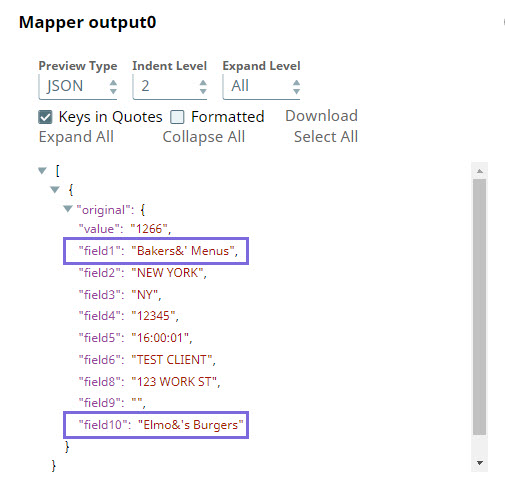In this article
...
Mapper Snap is a TRANSFORM-type Snap that transforms data and writes or passes it to the downstream Snap.
...
Works in Ultra Pipelines.
...
Limitation
Expressions used in this Snap, downstream of any Snowflake Snaps, that evaluate to very large values such as EXP(900) are displayed as Infinity in the input/output previews. However, you can see the exact evaluated values in the validation previews; hence, ignore this error. Learn more: Java Script Limitations in Displaying Numbers.
Snap Views
Type | Format | Number of Views | Examples of Upstream and Downstream Snaps | Description |
|---|---|---|---|---|
Input | Document |
| Binary-to-Document | This Snap can have a most one document or binary input view. If you do not specify an input view, the Snap generates a downstream flow of one row. |
Output | Document |
| Any Document Snap | This Snap has exactly one document or binary output view. |
Error | Error handling is a generic way to handle errors without losing data or failing the Snap execution. You can handle the errors that the Snap might encounter while running the Pipeline by choosing one of the following options from the When errors occur list under the Views tab. The available options are:
Learn more about Error handling in Pipelines. | |||
...
Field Name | Field Type | Description | ||||
|---|---|---|---|---|---|---|
Label* Default Value: Mapper | String | The name for the Snap. You can modify this to be more specific, especially if you have more than one of the same Snap in your Pipeline. | ||||
Null-safe access Default Value: Deselected | Checkbox | Select this checkbox to set the target value to null in case the source path does not exist. For example, | ||||
Pass through Default Value:Deselected | Checkbox | This setting determines if data should be passed through or not. If you select this checkbox, then all the original input data is passed into the output document together with the data transformation results. If you deselect this checkbox, then only the data transformation results that are defined in the mapping section appear in the output document and the input data is discarded.
When to always select Pass through Always select Pass through if you plan to leave the Target path field blank; else, the Snap displays an error that the field that you want to delete does not exist. This is the expected behavior. For example, you have an input file that contains a number of attributes; but you need only two of these downstream. So, you connect a Mapper to the downstream Snap supplying the input file, select the two attributes you need by listing them in the Expression fields, leave the Target path field blank, and select Pass through. When you execute the Pipeline, this Snap evaluates the input documents/binary data and picks up the two attributes that you want, and passes the entire document/binary data through to the Target schema. From the list of available attributes in the Target Schema, the Mapper Snap picks up the two attributes you listed in the Expression fields, and passes them as output. However, if you had not selected the Pass through checkbox, the Target Schema would be empty, and the Mapper would display a | ||||
Transformations* | Use this field set to configure the settings for data transformations. | |||||
Mapping Root Default Value: $ | String/Suggestion | Specify the sub-section of the input data to be mapped. Learn More: Understanding the Mapping Root. | ||||
Input Schema | Dropdown list | Select the input data (that comes from the upstream Snap) that you want to transform. Drag the item you want to map and place it under the Mapping table. | ||||
Mapping table | Use this field set to specify the source path, expression, and target path columns used to map schema structure. | |||||
Expression Default Value: N/A | String/Expression | Specify the expression to write to the target path. Expressions that are evaluated will remove the source targets at the end of the run.
Lear More: Understanding Expressions in SnapLogic and Using Expressions for usage guidelines.
| ||||
Target path Default Value: N/A | String/Suggestion | Specify the target path at which the expression should be written. Target Path Recommendation
For example, you have the Expression $Emp.Emp_Personal.FirstName in one of your Pipelines. And you have set the Target path for this expression as $FirstName. Now, if you use the expression $Emp.Emp_Personal.FirstName in a new Pipeline, then Iris suggests $FirstName as one of the recommended Target paths. This helps you standardize the naming standards within your org. The following video illustrates how Iris recommends Target path in a Mapper Snap: | ||||
Snap Execution | Dropdown list | Select one of the three modes in which the Snap executes. Available options are:
| ||||
...
If the Escape Character is | Use Expression | Sample Output | ||
|---|---|---|---|---|
Single quote (') | JSON: $original.mapValues((value,key)=> value.toString().replaceAll("'","''")) OR $original.mapValues((value,key)=> value.toString().replaceAll("'","\''")) CSV: $[' Business-Name'].replace ("'","''") | |||
Ampersand (&) | JSON: $original.mapValues((value,key)=> value.toString().replaceAll("'","\&'")) OR $original.mapValues((value,key)=> value.toString().replaceAll("'","&'")) CSV: $[' Business-Name'].replace ("'","&'") | |||
Backslash (\) | JSON: $original.mapValues((value,key)=> value.toString().replaceAll("'","\\'"))
CSV: $[' Business-Name'].replace ("'","\\'") |
In this way, you can customize the data to be passed on to downstream Snaps using the Expression field in the Mapper Snap.
...
Community Links:
| Insert excerpt | ||||||
|---|---|---|---|---|---|---|
|



